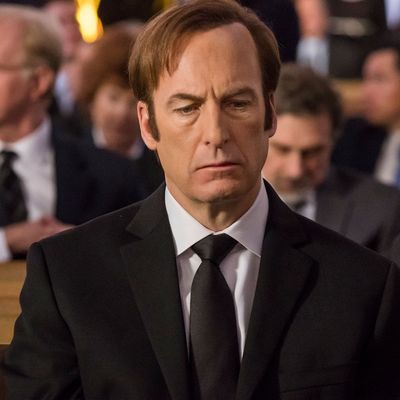
Better Call Saul,┬áwhich begins its fourth season┬áon AMC tonight, is all about specifics. ItÔÇÖs never in a hurry. It takes the time to look at situations and objects and think about what they mean. ItÔÇÖll get into a scene between, say, shady lawyer Jimmy McGill (Bob Odenkirk) and his business partner and girlfriend Kim Wexler (Rhea Seehorn), and stay in it for several minutes, imparting the most important information by watching their faces as they listen to each other. Or itÔÇÖll show ex-cop turned gangland fixer Mike Ehrmantraut (Jonathan Banks) starting a new job as a security consultant at German conglomerate Madrigal Elekromotive┬áby entering the place without announcing himself, then prowling around the open-floor-plan office, his bald dome gliding above the tops of cubicles like a sharkÔÇÖs fin.
As is tradition, the first scene in┬áBetter Call SaulÔÇÖs new season takes place in the present day, and cranks up the sense of jeopardy by fixating on OdenkirkÔÇÖs anxious face rather than ladling on expository dialogue. (Jimmy/Saul doesnÔÇÖt speak his first syllable for several minutes.) We return to the past through a series of transitions establishing that the story picks up immediately after the self-immolation of JimmyÔÇÖs brother Chuck (Michael McKean). Here, too, everything is conveyed with image and sound, climaxing with a touch that could almost be called magical realist.
Like its predecessor┬áBreaking Bad, this is a series you canÔÇÖt just half-watch while scrolling your phone, because if you do, you wonÔÇÖt know whatÔÇÖs going on. The show can be hard to follow even if youÔÇÖre watching closely, because so much of the plot is inferred. The season-four premiere has a scene where a character youÔÇÖve never met leaves his suburban home, goes to his car and sits in it for a while, failing to start the engine, then calls in to work to tell his boss heÔÇÖll be late. The next scene tells you why you met this man, and you laugh as you figure things out. In the same episode, we realize that Gus Fring (Giancarlo Esposito) suspects that Nacho Varga (Michael Mando) had something to do with Hector Salamanca (Mark Margolis) having a stroke, even though he canÔÇÖt possibly know the details. But you can tell he knows because of the way he glances at Nacho as the ambulance pulls away.
IÔÇÖm intentionally being vague here because, more so than most current series, the pleasures of┬áBetter Call Saul┬áare almost entirely visceral and emotional. ItÔÇÖs about what happens in the frame: what you see, what you hear, the looks on peopleÔÇÖs faces, and the thoughts that pass through their eyes as they contemplate their next move. Series creators Peter Gould and Vince Gilligan were smart to rethink the tone of this tale as they refocused the┬áBreaking Bad┬álens on Saul Goodman, a.k.a. Jimmy McGill. We know JimmyÔÇÖs going to make it through, along with Mike, Gus, and anyone else we met on Breaking Bad┬á(assuming, of course, that this series is set in the┬áBreaking Bad┬áuniverse and not some parallel timeline where anything can happen),┬áwhich means that what happens next is less important than what the characters are thinking and feeling as a result. We see the ultimate example of this philosophy in the seasonÔÇÖs fourth episode, which includes the most significant marker yet of JimmyÔÇÖs evolution into Saul, as well as peak performances from Seehorn and Odenkirk. The camera just sits on the two of them without cutting while Jimmy speaks and Kim listens. It sounds simple, and in filmmaking terms I guess it is, but itÔÇÖs one of the most wrenching moments in the series, so private that I felt I shouldnÔÇÖt have been watching it.
Breaking Bad┬áwas about self-willed moral rot and what it does to individuals, families, and communities.┬áBetter Call Saul┬áhas a touch of that, but it has a much tighter emphasis, zeroing in on one or two people at a time and distributing its attention rather democratically among the major characters, like a Robert AltmanÔÇôstyle ensemble piece about white-collar and blue-collar criminals in Albuquerque, New Mexico. ItÔÇÖs patient and resists the cartoonish hyperbole that made┬áBreaking Bad┬áso exciting and troublesome. Both do share a sincere interest in economic struggle ÔÇö something you donÔÇÖt normally see on American TV ÔÇö although this aspect, too, is expressed more subtly in the prequel series. Where┬áBreaking Bad┬ákicked off with its schoolteacher hero deciding to finance his cancer treatment and leave behind a nest egg for his family by cooking crystal meth, and in its final season served up such grandiose images as a gigantic brick of shrink-wrapped cash and a helicopter shot of Walter WhiteÔÇÖs mobile drug-lab tents popping up,┬áBetter Call Saul┬áis more inclined toward the understated gesture of resilience or diminution.
IÔÇÖm thinking specifically of a moment in the season premiere, as Mike spends his last few minutes in the glass booth where he works as a parking attendant. Director Minkie Spiro gives us four shots of Mike: from the back, from the side, in three-quarters view, and finally from head-on, as a co-worker arrives in the background to relieve him. Mike doesnÔÇÖt say anything until his colleague approaches ÔÇö the episode takes the opportunity to watch Jonathan Banks sitting there (and why wouldnÔÇÖt it, with a face that craggy-magnificent?) ÔÇö and once Mike exits the booth, we get a little moment thatÔÇÖs about a man enduring indignity with a positive mental attitude only because he knows heÔÇÖs leaving his job for another, better one. ÔÇ£Take it easy,ÔÇØ Mike says, by way of good-bye. ÔÇ£So, uh, the boss says heÔÇÖs gonna want the windbreaker,ÔÇØ his co-worker says. Pause. Mike says, ÔÇ£Course he does,ÔÇØ then takes it off, hands it over, and walks away.


